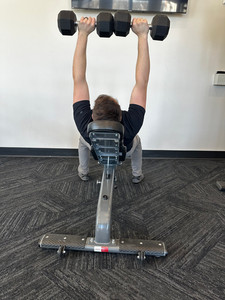Flat Bench Dumbbell Press Exercise
- Benjamin Mishleau
- Feb 4
- 2 min read
Updated: Mar 4
The flat bench dumbbell press has its roots in early strength training and bodybuilding, evolving from the traditional barbell bench press, which gained popularity in the early 1900's. As lifters sought more muscle activation and joint-friendly alternatives, dumbbells became a preferred option due to their ability to increase range of motion, improve muscle symmetry, and engage stabilizing muscles more effectively. The exercise became widely adopted in bodybuilding, powerlifting assistance work, and rehabilitation programs as it allowed for greater shoulder mobility and individualized movement patterns, reducing the risk of muscle imbalances and injury.
Purpose: Build upper body strength, improve muscle symmetry, and enhance pressing power for sports and functional movements.
Targeted Areas: pectoralis major, anterior deltoids, triceps brachii
Instructions:
Sit on a flat bench, holding a dumbbell in each hand, resting them on your thighs.
Carefully lie back while bringing the dumbbells to chest level, palms facing towards your toes.
Push the dumbbells upward until arms are fully extended, keeping a slight bend in the elbows at the top.
Slowly lower the dumbbells back to chest level, maintaining control and a full range of motion.
Perform for 8-10 reps for 2-3 sets.
Tips:
Keep your feet planted firmly on the ground for stability.
Engage your core and glutes to support your back.
Avoid locking out your elbows at the top to keep tension on the muscles.
Use a controlled, slow tempo to prevent excessive momentum.
If using heavy weights, consider having a spotter for safety.
Who Should Dumbbell Bench Press:
Beginners to Advanced Lifters – A versatile exercise that can be modified for different fitness levels.
Those Looking to Build Chest Strength and Muscle – Targets the pectorals, shoulders, and triceps for upper-body development.
Individuals with Muscle Imbalances – Dumbbells allow independent arm movement, correcting strength discrepancies.
Athletes and Functional Fitness Enthusiasts – Improves pressing power, stability, and coordination for sports and daily activities.
People with Limited Shoulder Mobility in Barbell Pressing – Offers a greater range of motion and reduces shoulder strain.
Who Shouldn’t Dumbbell Bench Press:
Individuals with Shoulder Injuries or Pain – Those with rotator cuff issues, impingement, or instability should proceed with caution or opt for modified pressing movements.
People with Severe Wrist or Elbow Pain – The load on the wrists and elbows can exacerbate joint discomfort.
Those with Lower Back Issues – Poor form or excessive arching can aggravate back pain; keeping the core engaged and feet planted can help mitigate risk.
Anyone Unable to Control the Weight – If stability is a concern, starting with lighter dumbbells or machine presses may be safer.
If It Causes Pain: If In doubt, if it causes pain, don't do it.









Comments